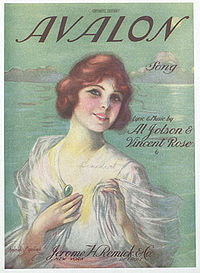- Avalon (Lied)
-
Avalon ist ein populärer Song von 1920, der von Al Jolson, Buddy DeSylva und Vincent Rose geschrieben wurde.[1]
Die erste Version des Songs wurde von Jolson 1921 aufgenommen. Jolson hatte ihn auch in den Musicals Sinbad (1918/19)[2][3] und Bombo (1921/22)[4][5] verwendet.
Der Song wurde bald zu einem populären Jazz-Standard; so haben u. a. Benny Goodman mehrmals, Cab Calloway (1934), Coleman Hawkins (1935) und Eddie Durham (1936) Versionen eingespielt. Das Benny Goodman-Quartett spielte den Song 1938 in dem berühmten Konzert in der Carnegie Hall.[6]
Die Melodie am Anfang des Songs ist aus der Arie E lucevan le stelle von Giacomo Puccinis Oper Tosca, und war nur ein wenig von Rose modifiziert.[1] Der Ricordi-Verlag als Agent von Puccini verklagte die Komponisten wegen Plagiats; Ricordi gewann den Rechtsstreit und bekam die Summe von 25.000 $ zugesprochen, außerdem alle künftigen Einnahmen aus dem Titel.[7]
Versionen
- Red Nichols and His Five Pennies (27. Februar 1928)
- George Monkhouse and his Cambridge University Quinquaginta Ramblers (12. März 1930)
- Spike Hughes and his Dance Orchestra (23. Mai 1930)
- Joel Shaw and his Orchestra (August 1932)
- Billy Cotton and his Band (21. Juli 1933)
- Casa Loma Orchestra (16. August 1934)
- Cab Calloway and his Orchestra (4. September 1934)
- Scott Wood and his Six Swingers (18. Dezember 1934; 1. September 1936)
- Joe Venuti and his Orchestra (26. Dezember 1934)
- KXYZ Novelty Band (29. Januar 1935)
- Coleman Hawkins (2. März 1935)
- Quintette of the Hot Club of France (Juli 1935)
- Jimmie Lunceford and his Orchestra (30. September 1935)
- Harry Roy and his Orchestra (8. November 1935)
- Val Rosing and his Swing Stars (18. November 1935)
- Ballyhooligans (7. Juli 1936)
- Benny Goodman Quartet (29. Juni 1937; 28. September 1937; 16. Januar 1938)
- Joe Daniels and his Hotshots (28. September 1937)
- Alix Combelle et son Orchestre (4. Oktober 1937)
- Harry James and his Orchestra (13. Juli 1939; 8. November 1939)
- Willie Lewis and his Negro Band (27. Juni 1941)[8]
Einzelnachweise
- ↑ a b Beschreibung bei JazzStandards.com (Engl.)
- ↑ Ruhlmann, William (2004). Breaking Records: 100 Years of Hits". Routledge. ISBN 0415943051. S. 42
- ↑ Kenrick, John (2003). Al Jolson: A Biography.
- ↑ Furia, Philip; Lasser, Michael L. (2006). America's Songs: The Stories Behind the Songs of Broadway, Hollywood, and Tin Pan Alley. CRC Press. S. 24. ISBN 0415972469.
- ↑ Bloom Ken (2004). Broadway: Its History, People, and Places: An Encyclopedia. Taylor & Francis. S. 96. ISBN 0415937043.
- ↑ Jasen, David A. (2002). A Century of American Popular Music: 2000 Best-Loved and Remembered Songs (1899-1999). Taylor & Francis. S. 14. ISBN 0415937000.
- ↑ Ken Bloom: The American Songbook - The Singers, the Songwriters, and the Songs - 100 Years of American Popular Music - The Stories of the Creators and Performers. New York City, Black Dog & Leventhal, 2005 ISBN 1-57912-448-8) S. 77.
- ↑ Crawford, Richard; Magee, Jeffrey (1992). Jazz Standards on Record, 1900–1942: A Core Repertory. Center for Black Music Rsrch. S. 6–7. ISBN 0929911032.
Wikimedia Foundation.

